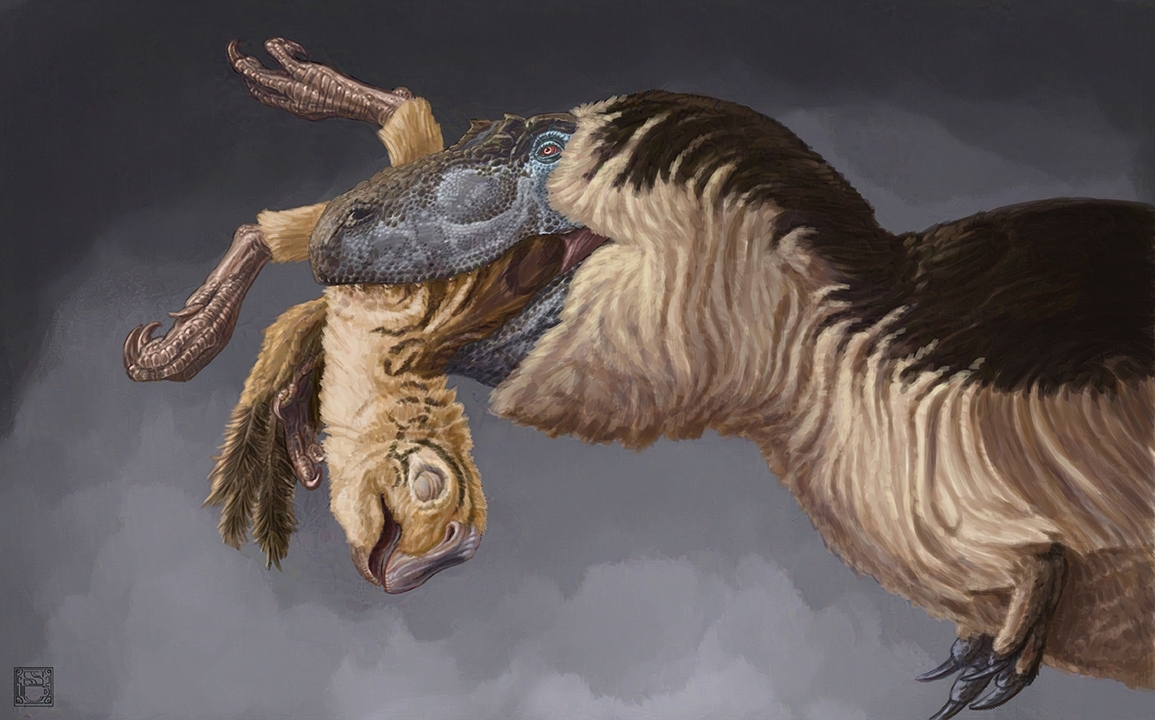When it comes to eating chicken – a living species of dinosaur – we all have our preferences. I enjoy white meat, though others may like a good helping of chicken wings, dark meat (yuck!), or drumsticks.
It appears that some predatory dinosaurs preferred the legs of their prey – bones and all – as demonstrated by a newly described specimen of a teenage Tyrannosaur.
On December 8th, 2023, a joint research team working out of the Badlands of Alberta, Canada, published a paper describing a skeleton of Gorgosaurus libratus discovered almost 15 years prior. The specimen (TMP 2009.12.14) consists of the body cavity of the animal, portions of its skull, and a few limbs[i]. The small size of the individual (approximately one-eighth the weight of an adult), combined with analysis of its bone tissues, indicates that it was immature, somewhere between 5 and 7 years old.

Despite its youth, the preserved stomach contents of the Gorgosaurus indicate it was an active and effective predator. Nestled within its abdominal cavity are the limbs of two baby Citipes, omnivorous dinosaurs distantly related to the Mongolian Oviraptor. The bones show signs of being partially digested, with those located towards the rear of the Gorgosaurus being more damaged than those at the front. The damage has been interpreted as a result of the predator’s stomach acid, suggesting that the Gorgosaurus consumed the two Citipes on separate occasions, perhaps returning to the same colony to pluck the vulnerable young away.
The extent of digestion is relatively minimal, indicating that the Citipes became consumed close to the death of the Gorgosaurus. Indigestion may have been the cause of death, though fossils of Tyrannosaur coprolites – or fossilized poop – also contain bone fragments of their prey[ii]. This suggests that Tyrannosaurids regularly ingested bones and relied on strong stomach acids to digest their prey, a strategy shared by modern reptiles such as Komodo Dragons and Crocodiles. Certainly, life is no cakewalk for juvenile animals in the past or present. Thus, the reason why this Gorgosaurus died remains a mystery.
Even more fascinating than the fossil itself is its implications for Tyrannosaur ecology. Paleontologists have long theorized that some Tyrannosaurids, namely Tyrannosaurus rex, underwent an ontogenetic niche shift as they grew from juveniles into adults. In other words, some paleontologists think juvenile Tyrannosaurids occupied a different role in their ecosystems than their parents, living separately and preying on distinct prey species. This theory has helped explain why few mid-sized carnivores were present in the Late Cretaceous period of North America, with the role instead being filled by the growing young of various Tyrannosaur genera.
While this theory has been accepted by many paleontologists, it lacked definitive fossil evidence – until now. The baby Citipes were too small for adult Gorgosaurus to bother hunting, as the 9–12-kilogram (20-26 pound) dinosaurs would have been mere morsels for a multi-tonne Tyrannosaur. Instead, the adults were likely preying on the abundant Hadrosaurs and Ceratopsians that lived in the Late Cretaceous of Alberta, herbivores large enough to provide substantial nutrition for these ferocious predators.

The ontogenetic niche theory may not have applied to all Tyrannosaurids, however. Bone beds of at least two North American Tyrannosaurid genera – Albertosaurus and Daspletosaurus – have been discovered, which show that multiple individuals from different age groups may have lived together. Gorgosaurus’ relation to these two species is particularly noteworthy; Albertosaurus is Gorgosaurus’ closest relative amongst Tyrannosaurids, and Daspletosaurus lived alongside Gorgosaurus. The Tyrannosaurids clearly showed tremendous diversity in their behaviours amongst contemporary genera, allowing multiple large predators to live alongside one another. This could explain how the lineage became the dominant predators across the northern hemisphere during the Late Cretaceous.
Fossils that preserve evidence of predator-prey relationships are rare, but ones like this are downright incredible. Not only can we learn about what a teenage Tyrannosaur hunted and what body parts it had a taste for, but also how its species and relatives fit into the ecosystem around them. With continued discoveries of incredible specimens illustrating dinosaur behaviour, one can only wonder what is next…
…fingers crossed for it to be Spinosaurus!
Thank you for reading today’s article! Following the time of Gorgosaurus, the teenage offspring of Tyrannosaurus were wreaking havoc across the American West – or were they a different species? If you want to know the truth about Nanotyrannus, I suggest reading it here at Max’s Blogosaurus!
I do not take credit for any images found in this article. All images come courtesy of the respective artists noted within this post.
Header image courtesy of Sean Closson, found at his twitter here.
Works Cited:
[i] Therrien, François, et al. “Exceptionally Preserved Stomach Contents of a Young Tyrannosaurid Reveal an Ontogenetic Dietary Shift in an Iconic Extinct Predator.” Science Advances, vol. 9, no. 49, American Association for the Advancement of Science (AAAS), Dec. 2023. Crossref, https://doi.org/10.1126/sciadv.adi0505.
[ii] Black, Riley. “Tyrannosaurus Scat.” Smithsonian Magazine, 17 Nov. 2013, http://www.smithsonianmag.com/science-nature/tyrannosaurus-scat-96841015.


One reply on “The Gorgon’s Last Meal: Fossilized Stomach Contents of a Teenage Tyrannosaur”
[…] we haven’t even cracked January 15th yet! For more Tyrannosaurid content, I suggest reading “The Gorgon’s Last Meal: Fossilized Stomach Contents of a Teenage Tyrannosaur” here at Max’s […]
LikeLike